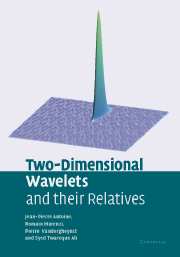Book contents
- Frontmatter
- Contents
- Prologue
- 1 Warm-up: the 1-D continuous wavelet transform
- 2 The 2-D continuous wavelet transform
- 3 Some 2-D wavelets and their performance
- 4 Applications of the 2-D CWT. I: image processing
- 5 Applications of the 2-D CWT. II: physical applications
- 6 Matrix geometry of wavelet analysis. I
- 7 Matrix geometry of wavelet analysis. II
- 8 Minimal uncertainty and Wigner transforms
- 9 Higher-dimensional wavelets
- 10 Spatio-temporal wavelets and motion estimation
- 11 Beyond wavelets
- Epilogue
- Appendix: Some elements of group theory
- References
- Index
4 - Applications of the 2-D CWT. I: image processing
Published online by Cambridge University Press: 19 August 2009
- Frontmatter
- Contents
- Prologue
- 1 Warm-up: the 1-D continuous wavelet transform
- 2 The 2-D continuous wavelet transform
- 3 Some 2-D wavelets and their performance
- 4 Applications of the 2-D CWT. I: image processing
- 5 Applications of the 2-D CWT. II: physical applications
- 6 Matrix geometry of wavelet analysis. I
- 7 Matrix geometry of wavelet analysis. II
- 8 Minimal uncertainty and Wigner transforms
- 9 Higher-dimensional wavelets
- 10 Spatio-temporal wavelets and motion estimation
- 11 Beyond wavelets
- Epilogue
- Appendix: Some elements of group theory
- References
- Index
Summary
The 2-D CWT has been used by a number of authors, in a wide variety of problems [Com89,Mey91,Mey93]. In all cases, its main use is for the analysis of images, since image synthesis or compression problems are rather treated with the DWT. In particular, the CWT can be used for the detection or determination of specific features, such as a hierarchical structure, edges, filaments, contours, boundaries between areas of different luminosity, etc. Of course, the type of wavelet chosen depends on the precise aim. An isotropic wavelet (e.g. a Mexican hat) often suffices for pointwise analysis, but a directional wavelet (e.g. a Morlet or a conical wavelet) is necessary for the detection of oriented features in the signal. Somewhat surprisingly, a directional wavelet is often more efficient in the presence of noise.
In the next two chapters, we will review a number of such applications, including some nonlinear extensions of the CWT. First, in the present chapter, we consider various aspects of image processing. Then, in Chapter 5, we will turn to several fields of physics where the CWT has made an impact. Some of the applications are rather technical and use specific jargon. We apologize for that and refer the reader to the original papers for additional information.
Information
- Type
- Chapter
- Information
- Two-Dimensional Wavelets and their Relatives , pp. 125 - 174Publisher: Cambridge University PressPrint publication year: 2004
